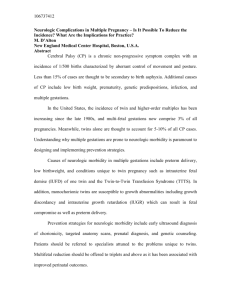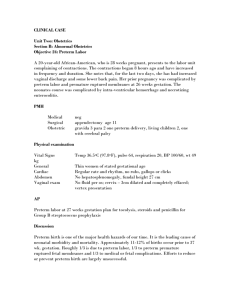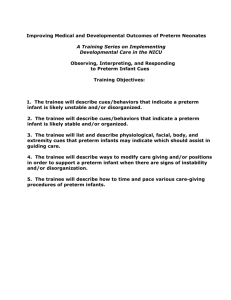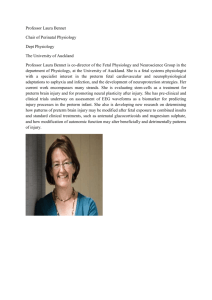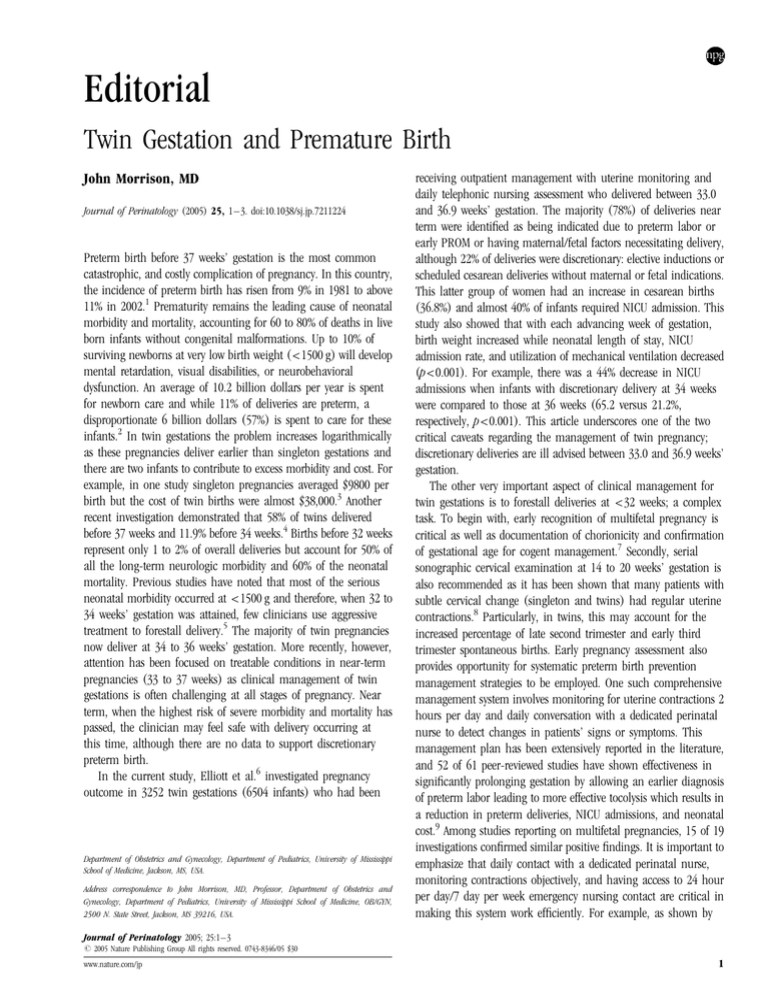
Editorial
Twin Gestation and Premature Birth
John Morrison, MD
Journal of Perinatology (2005) 25, 1–3. doi:10.1038/sj.jp.7211224
Preterm birth before 37 weeks’ gestation is the most common
catastrophic, and costly complication of pregnancy. In this country,
the incidence of preterm birth has risen from 9% in 1981 to above
11% in 2002.1 Prematurity remains the leading cause of neonatal
morbidity and mortality, accounting for 60 to 80% of deaths in live
born infants without congenital malformations. Up to 10% of
surviving newborns at very low birth weight (<1500 g) will develop
mental retardation, visual disabilities, or neurobehavioral
dysfunction. An average of 10.2 billion dollars per year is spent
for newborn care and while 11% of deliveries are preterm, a
disproportionate 6 billion dollars (57%) is spent to care for these
infants.2 In twin gestations the problem increases logarithmically
as these pregnancies deliver earlier than singleton gestations and
there are two infants to contribute to excess morbidity and cost. For
example, in one study singleton pregnancies averaged $9800 per
birth but the cost of twin births were almost $38,000.3 Another
recent investigation demonstrated that 58% of twins delivered
before 37 weeks and 11.9% before 34 weeks.4 Births before 32 weeks
represent only 1 to 2% of overall deliveries but account for 50% of
all the long-term neurologic morbidity and 60% of the neonatal
mortality. Previous studies have noted that most of the serious
neonatal morbidity occurred at <1500 g and therefore, when 32 to
34 weeks’ gestation was attained, few clinicians use aggressive
treatment to forestall delivery.5 The majority of twin pregnancies
now deliver at 34 to 36 weeks’ gestation. More recently, however,
attention has been focused on treatable conditions in near-term
pregnancies (33 to 37 weeks) as clinical management of twin
gestations is often challenging at all stages of pregnancy. Near
term, when the highest risk of severe morbidity and mortality has
passed, the clinician may feel safe with delivery occurring at
this time, although there are no data to support discretionary
preterm birth.
In the current study, Elliott et al.6 investigated pregnancy
outcome in 3252 twin gestations (6504 infants) who had been
Department of Obstetrics and Gynecology, Department of Pediatrics, University of Mississippi
School of Medicine, Jackson, MS, USA.
Address correspondence to John Morrison, MD, Professor, Department of Obstetrics and
Gynecology, Department of Pediatrics, University of Mississippi School of Medicine, OB/GYN,
2500 N. State Street, Jackson, MS 39216, USA.
receiving outpatient management with uterine monitoring and
daily telephonic nursing assessment who delivered between 33.0
and 36.9 weeks’ gestation. The majority (78%) of deliveries near
term were identified as being indicated due to preterm labor or
early PROM or having maternal/fetal factors necessitating delivery,
although 22% of deliveries were discretionary: elective inductions or
scheduled cesarean deliveries without maternal or fetal indications.
This latter group of women had an increase in cesarean births
(36.8%) and almost 40% of infants required NICU admission. This
study also showed that with each advancing week of gestation,
birth weight increased while neonatal length of stay, NICU
admission rate, and utilization of mechanical ventilation decreased
(p<0.001). For example, there was a 44% decrease in NICU
admissions when infants with discretionary delivery at 34 weeks
were compared to those at 36 weeks (65.2 versus 21.2%,
respectively, p<0.001). This article underscores one of the two
critical caveats regarding the management of twin pregnancy;
discretionary deliveries are ill advised between 33.0 and 36.9 weeks’
gestation.
The other very important aspect of clinical management for
twin gestations is to forestall deliveries at <32 weeks; a complex
task. To begin with, early recognition of multifetal pregnancy is
critical as well as documentation of chorionicity and confirmation
of gestational age for cogent management.7 Secondly, serial
sonographic cervical examination at 14 to 20 weeks’ gestation is
also recommended as it has been shown that many patients with
subtle cervical change (singleton and twins) had regular uterine
contractions.8 Particularly, in twins, this may account for the
increased percentage of late second trimester and early third
trimester spontaneous births. Early pregnancy assessment also
provides opportunity for systematic preterm birth prevention
management strategies to be employed. One such comprehensive
management system involves monitoring for uterine contractions 2
hours per day and daily conversation with a dedicated perinatal
nurse to detect changes in patients’ signs or symptoms. This
management plan has been extensively reported in the literature,
and 52 of 61 peer-reviewed studies have shown effectiveness in
significantly prolonging gestation by allowing an earlier diagnosis
of preterm labor leading to more effective tocolysis which results in
a reduction in preterm deliveries, NICU admissions, and neonatal
cost.9 Among studies reporting on multifetal pregnancies, 15 of 19
investigations confirmed similar positive findings. It is important to
emphasize that daily contact with a dedicated perinatal nurse,
monitoring contractions objectively, and having access to 24 hour
per day/7 day per week emergency nursing contact are critical in
making this system work efficiently. For example, as shown by
Journal of Perinatology 2005; 25:1–3
r 2005 Nature Publishing Group All rights reserved. 0743-8346/05 $30
www.nature.com/jp
1
Morrison
Dyson et al.,10,11 if the nurses are not dedicated only to such a
comprehensive system, or if an inappropriate monitor is used,
results can change from a positive effect on prevention of preterm
birth to no noticeable difference. In addition, if there is no
perinatal nursing service, or if the physicians cannot use the
uterine activity clinically, preterm births before 32 to 34 weeks will
not be reduced. For example, in one multicenter study, 254 women
at high risk and 52 women at low risk for preterm birth had
uterine contraction monitoring for 2 hours per day and the authors
noted an increased contraction frequency for patients delivering at
<35 weeks’ gestation compared to women delivering at term.12
However, physicians were blinded to the uterine activity data
and no perinatal nursing service was utilized. Inexplicably, the
authors concluded that monitoring uterine activity was not
helpful to clinicians in preventing preterm birth. In contrast,
Elliott, Lam, and others have published many articles showing
that a comprehensive management system including home
electronic contraction monitoring works well (particularly when
aggressive tocolytic therapy is employed in those developing
preterm labor) in singleton and twin gestations if all system
components are present.9
Back to the other end of the gestational age spectrum, the
clinical findings in the current paper by Elliott agree with other
studies in the literature regarding the benefit of avoiding
discretionary delivery. One investigator noted that there had
been a 14% increase in preterm labor induction between 34
and 36 weeks in twin gestation.13 In another large study 8000 twin
pairs over a 10-year period of time were studied and
significantly higher perinatal mortality/morbidity rates were
noted at r35 weeks’ gestation.14 Büscher also found a
difference in the birth weight for neonates in twin deliveries
delivered at >37 weeks’ gestation versus those who delivered
between 34.0 and 36.9 weeks, with nearly 70% of twin
gestations delivering at 34.0 to 36.9 weeks being admitted to the
NICU.15 Other studies have well documented the link between
gestational age at delivery and NICU admission as well as
nursery length of stay.
In summary, it appears that twin gestations achieve the best
preterm birth rate reduction by early confirmation of gestational
age and chorionicity, serial cervical length assessment, as well as,
comprehensive preterm birth prevention management, and
excellent clinical antepartum assessment, all of which enables such
gestations to have the greatest chance of attaining a gestational age
of at least 33 weeks. The message by Elliott et al., in this issue of
The Journal is for the obstetrician to be wary of instituting or
failing to avoid delivery of twin gestations between 33.0 and 36.9
weeks’ gestation when it is not truly indicated. One must remember
that although neonatal morbidity and higher health care costs
occur with delivery at <32 weeks’ gestation, that this group
comprises the vast minority of gestations, as upwards of 95% of
preterm deliveries occur between 33 and 37 weeks’ gestation.
2
Twin Gestation and Premature Birth
Obviously, if there are fetal/maternal indications for delivery,
physician judgment is needed to determine whether the baby is
better off in utero or in the nursery. On the other hand, physicianallowed or discretionary deliveries between 33.0 and 36.9 weeks’
gestation should be abandoned because they correspond to an
increase in NICU admissions and hospital days, thus
unnecessarily expanding neonatal morbidity as well as cost.
Therefore, perhaps it is time for an old dog to learn new tricks. In
the past, I had taught my residents that the battle had been won if
we could get pregnancies to 34 weeks.16 Although a desirable
achievement, reaching 34 weeks does not entitle the physician to
ignore the consequences of near-term delivery. Without
indications for delivery we are best advised to use all our clinical
skills to continue the gestation, as nature intended, to at least 36 to
37 weeks in utero.
References
1. Goldenberg RL. The management of preterm labor. Obstet Gynecol
2002;100:1020–37.
2. St John EB, Nelson KG, Oliver SP, Bishnoi RR, Goldenberg RL. Cost of
neonatal care according to gestational age at birth and survival status. Am J
Obstet Gynecol 2000;182:170–5.
3. Callahan TL, Hall JE, Ettner SL, Christiansen CL, Greene MF, Crowley Jr WF.
The economic impact of multiple-gestation pregnancies and the
contribution of assisted-reproduction techniques to their incidence. N Engl
J Med 1994;331(4):270–1.
4. Joseph KS, Allen AC, Dodds L, Vincer MJ, Armson BA. Causes and
consequences of recent increases in preterm birth among twins. Obstet
Gynecol 2001;98:57–64.
5. Ananth CV, Joseph KS, Smulian JC. Trends in twin neonatal mortality
rates in the United States, 1989 through 1999: influence of birth
registration and obstetric intervention. Am J Obstet Gynecol 2004;190:
1313–21.
6. Elliott JP, Istwan NB, Collins A, Rhea D, Stanziano G. Indicated and nonindicated preterm delivery in twin gestations: impact on neonatal outcome
and cost. Journal of Perinatol 2005.
7. Dalton ME, Goldman CJ, Morgan MA, Robinson JN. Multiple pregnancy:
knowledge and practice patterns of obstetricians and gynecologists. PubMed
2004;104(2):232–7.
8. Berghella V, Talucci M, Desai A. Does transvaginal sonographic
measurement of cervical length before 14 weeks predict preterm
delivery in high risk pregnancies? Ultrasound Obstet Gynaecol 2003;21(2):
140–4.
9. Morrison JC, Chauhan SP. Current status of home uterine activity
monitoring. Clin Perinatol 2003;30:757–801.
10. Dyson DC, Crites YM, Ray DA, Armstrong MA. Prevention of preterm birth in
high-risk patients: the role of education and provider contact versus home
uterine monitoring. Am J Obstet Gynecol 1991;164:756–62.
11. Dyson DC, Danbe KH, Bamber JA, et al. Monitoring women at risk for
preterm labor. N Engl J Med 1998;338:15–9.
12. Iams JD, Newman RB, Thom EA, et al. Frequency of uterine contractions
and the risk of spontaneous preterm delivery. N Engl J Med 2002;346:
250–5.
Journal of Perinatology 2005; 25:1–3
Twin Gestation and Premature Birth
13. Joseph KS, Allen AC, Dodds L, Vincer MJ, Armson BA. Causes and
consequences of recent increases in preterm birth among twins. Obstet
Gynecol 2001;98:57–64.
14. Hartley RS, Emanuel I, Hitti J. Perinatal mortality and neonatal morbidity
ranges among twin pairs at different gestational ages: optimal delivery
timing at 37 to 38 weeks’ gestation. Am J Obstet Gynecol 2001;184:451–8.
Journal of Perinatology 2005; 25:1–3
Morrison
15. Büscher U, Horstkamp B, Wessel J, Chen FCK, Dudenhausen JW. Frequency
and significance of preterm delivery in twin pregnancies. Int J Gynaecol
Obstet 2000;69:1–7.
16. Fox MD, Allbert JR, McCaul JF, Martin RW, McLaughlin BN, Morrison
JC. Neonatal morbidity between 34 weeks’ gestation. J Perinatol
1993;XIII:349–53.
3

